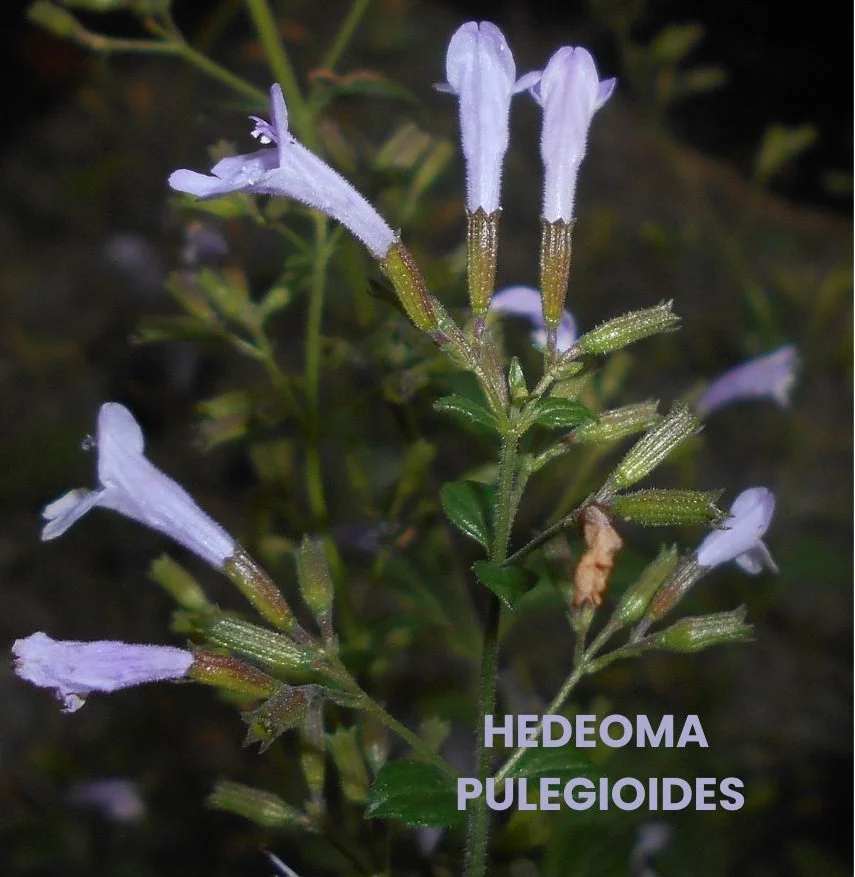Hedeoma Pulegioides, commonly known as Pennyroyal, is a plant used in homeopathy primarily for addressing female reproductive symptoms often associated with nervous disturbances.
It is also noted for its effects on the urinary and digestive systems.

SOURCE INFORMATION
Scientific Classification
- Kingdom: Plantae
- Clade: Angiosperms
- Order: Lamiales
- Family: Lamiaceae
- Genus: Hedeoma
- Species: H. pulegioides
Common Names
- Pennyroyal
Origin and Habitat
Hedeoma Pulegioides is native to North America and commonly found in fields, forests, and along roadsides. It thrives in temperate climates.
Historical and Medicinal Use
Traditionally, Pennyroyal has been used for its aromatic properties and as a folk remedy for various ailments.
In homeopathy, it is particularly effective for female symptoms associated with nervous disturbances, urinary issues, and digestive discomfort.
DRUG PATHOGENESIS
- Hedeoma Pulegioides primarily affects the female reproductive system, urinary tract, and digestive system.
- It is known for its ability to relieve symptoms such as bearing-down pains, urinary irritation, and flatulent colic.
KEY CHARACTERISTICS
HEAD
- Dull, Heavy Feeling in the Morning: A sensation of heaviness and dullness in the head, most noticeable upon waking.
- Sore Pain, As If from a Cut: Sharp, cutting pain in the head.
- Weakness and Faintness: General weakness and a feeling of faintness, which improve when lying down.
STOMACH
- Gastritis: Inflammation of the stomach lining, with pain triggered by eating or drinking anything.
- Tongue Coated with a Thin White Layer: The tongue is covered with a light white coating, often associated with digestive issues.
- Nausea: A constant feeling of wanting to vomit.
ABDOMEN
- Distended, Sore, and Sensitive: The abdomen feels bloated, tender, and highly sensitive to touch.
URINE
- Frequent Urging and Cutting Pains: A constant need to urinate accompanied by sharp pains.
- Pain Along the Left Ureter: Discomfort following the path of the left ureter (the tube connecting the kidney to the bladder).
- Dragging Pain from the Kidney to the Bladder: A pulling sensation from the kidney down to the bladder.
- Dull Burning Pain Over the Left Kidney: Persistent, dull burning pain in the area of the left kidney.
- Burning Irritation at the Neck of the Bladder: Intense burning at the bladder’s opening, causing a frequent and urgent need to urinate, which is relieved somewhat after urination.
FEMALE
- Bearing-Down Pains with Significant Backache: A sensation of downward pressure in the pelvic region combined with severe back pain, worsened by any movement.
- Leucorrhoea with Itching and Burning: Abnormal vaginal discharge accompanied by itching and burning sensations.
- Congested and Painful Ovaries: The ovaries feel swollen and sore, with painful, spasmodic contractions.
EXTREMITIES
- Pain in the Thumb Joint: Discomfort specifically in the joint of the thumb.
- Pain, Coldness, and Paretic Condition: General pain and coldness in the limbs, along with a weakened (paretic) state.
- Twitching, Jerking, and Soreness: Involuntary muscle movements and general soreness.
- Tendo-Achilles Painful, As If Sprained and Swollen: The Achilles tendon feels strained and swollen, causing pain when walking.
MODALITIES
- Better: Lying down, urinating.
- Worse: Movement, stress, physical exertion.
RELATIONSHIP WITH OTHER DRUGS
Compare with
- Mentha: For its aromatic and digestive properties.
- Sepia: Known for treating female reproductive issues.
- Lilium: Used for gynaecological and urinary symptoms.
- Ocimum: For uric acid diathesis and pain in ureters.
- Hedera Helix (Common Ivy): For delirium, convulsions, and chronic conditions.
- Glechoma Hederacea (Ground Ivy): For hemorrhoids, diarrhea, and respiratory irritation.
DOSE
- Potency: First potency is commonly used.
Frequently Asked Questions (FAQs)
What is Hedeoma Pulegioides (Pennyroyal) used for in homeopathy?
- Hedeoma Pulegioides is primarily used to address female reproductive symptoms, urinary issues, and digestive discomfort.
- It is particularly effective for treating bearing-down pains, urinary irritation, and flatulent colic.
What are the key symptoms that Hedeoma Pulegioides addresses?
- The key symptoms include dull, heavy head feeling, gastritis, abdominal distension, frequent and painful urination, bearing-down pains, and pain in the extremities.
How does Hedeoma Pulegioides affect the urinary system?
- It causes frequent urging to urinate with cutting pains, pain along the left ureter, dragging pain from the kidney to the bladder, and burning irritation at the neck of the bladder, leading to frequent, intense desire to urinate.
Can Hedeoma Pulegioides be used for digestive issues?
- Yes, it is useful for treating gastritis, abdominal distension, soreness, and sensitivity.
- It helps alleviate pain caused by any intake and reduces nausea.
What are the modalities of Hedeoma Pulegioides?
- Symptoms improve when lying down and urinating but worsen with movement, stress, and physical exertion.
How is Hedeoma Pulegioides typically administered in homeopathy?
- It is typically administered in the first potency, depending on the individual’s symptoms and the practitioner’s recommendation.
Are there any other homeopathic remedies similar to Hedeoma Pulegioides?
- Similar remedies include Mentha for digestive issues, Sepia for female reproductive symptoms, Lilium for gynaecological and urinary symptoms, and Ocimum for uric acid diathesis and ureter pain.
Glossary of Difficult Words
- Leucorrhea: A thick, whitish or yellowish vaginal discharge.
- Gastritis: Inflammation of the stomach lining.
- Ureter: The duct by which urine passes from the kidney to the bladder.
- Tendo-Achilles: The tendon connecting calf muscles to the heel bone.
